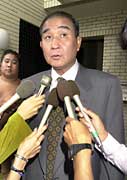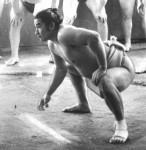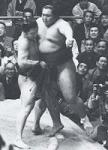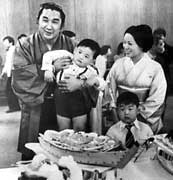|
Sumo News
(archives)
May
30th
Futagoyama Oyakata Dies
 Former
Ozeki and the current Futagoyama-oyakata, Hanada Mitsuru, died May 30th
after a battle with mouth cancer. Futagoyama-oyakta fought as Takanohana
during his active career and gained immense popularity as he rose to the
Ozeki ranks. In more recent times, however, he is best remembered for
apprenticing his two sons to the rank of Yokozuna, the only brotherly
tandem to have accomplished the feat in Takanohana and Wakanohana III.
Futagoyama-oyakata first entered sumo in 1965 at the Natsu Basho where
he was apprenticed by his older brother and former Yokozuna Wakanohana
I, who then led the Futagoyama-beya. In less than three years,
Futagoyama-oyakata achieved sekitori Former
Ozeki and the current Futagoyama-oyakata, Hanada Mitsuru, died May 30th
after a battle with mouth cancer. Futagoyama-oyakta fought as Takanohana
during his active career and gained immense popularity as he rose to the
Ozeki ranks. In more recent times, however, he is best remembered for
apprenticing his two sons to the rank of Yokozuna, the only brotherly
tandem to have accomplished the feat in Takanohana and Wakanohana III.
Futagoyama-oyakata first entered sumo in 1965 at the Natsu Basho where
he was apprenticed by his older brother and former Yokozuna Wakanohana
I, who then led the Futagoyama-beya. In less than three years,
Futagoyama-oyakata achieved sekitori  status for the 1968 Haru basho and became at the time, the youngest
rikishi ever to do so despite his 100 kilogram frame. He was promoted to
the Makuuchi division for the Kyushu basho of the same year and was
promoted to the rank of Ozeki after the 1972 Aki Basho, a rank he held
until his retirement at the Hatsu Basho in 1981. Futagoyama-oyakata still
holds the record for number of basho maintaining Ozeki status.
Futagoyama-oyakata was an excellent competitive swimmer in junior high
school setting many records. He was even being touted as a possible
representative in the Olympics, but the oyakata then stated, "one
can't make a living in swimming," so he quit that sport and entered
professional sumo. Futagoyama-oyakata attributed his then
record-breaking rise through the sumo ranks to the strict
status for the 1968 Haru basho and became at the time, the youngest
rikishi ever to do so despite his 100 kilogram frame. He was promoted to
the Makuuchi division for the Kyushu basho of the same year and was
promoted to the rank of Ozeki after the 1972 Aki Basho, a rank he held
until his retirement at the Hatsu Basho in 1981. Futagoyama-oyakata still
holds the record for number of basho maintaining Ozeki status.
Futagoyama-oyakata was an excellent competitive swimmer in junior high
school setting many records. He was even being touted as a possible
representative in the Olympics, but the oyakata then stated, "one
can't make a living in swimming," so he quit that sport and entered
professional sumo. Futagoyama-oyakata attributed his then
record-breaking rise through the sumo ranks to the strict  leadership and guidance of his older brother, former Yokozuna Wakanohana
I who lamented, "he [Futagoyama-oyakata] would never rest until he
had his opponent out of the dohyo." Futagoyama-oyakata's style was
sometimes even branded as "circus sumo." Highlights of his
career include a defeat of Yokozuna Taiho in Natsu 1971 as a Komusubi
that spurred Taiho's subsequent retirement and his first Makuuchi yusho
in Haru 1975 where he defeated of Yokozuna Kitanoumi in a yusho playoff
bout that drew a television ratings percentage over 50 percent.
Futagoyama-oyakata would take the yusho one other time, but he was never
able to get over the Yokozuna hump. At the time of his retirement in
1981, he expressed, "I did the best I could. My popularity was a
burden at times, but without the support of my fans, I would have only
lasted in the Ozeki ranks for 20 basho or so."
leadership and guidance of his older brother, former Yokozuna Wakanohana
I who lamented, "he [Futagoyama-oyakata] would never rest until he
had his opponent out of the dohyo." Futagoyama-oyakata's style was
sometimes even branded as "circus sumo." Highlights of his
career include a defeat of Yokozuna Taiho in Natsu 1971 as a Komusubi
that spurred Taiho's subsequent retirement and his first Makuuchi yusho
in Haru 1975 where he defeated of Yokozuna Kitanoumi in a yusho playoff
bout that drew a television ratings percentage over 50 percent.
Futagoyama-oyakata would take the yusho one other time, but he was never
able to get over the Yokozuna hump. At the time of his retirement in
1981, he expressed, "I did the best I could. My popularity was a
burden at times, but without the support of my fans, I would have only
lasted in the Ozeki ranks for 20 basho or so."
 Futagoyama-oyakata's two sons, Masaru and Koji, would sit in the seiza
style and watch their father's performance on television. When the two
boys decided to enter professional sumo themselves, their father
proclaimed that he would end his father-son ties with them and treat
them as any other rikishi forcing them to perform ferocious keiko.
Besides his two sons, Futagoyama-oyakata also apprenticed many other
sekitori who would reach Ozeki/sanyaku status including Takanonami,
Akinoshima, Takatoriki, Misugisato, Wakakosho, and Naminohana. The
dominance of his Futagoyama-beya and the popularity of his two sons
created a fervor surrounding the sport that peaked in the latter half of
the nineties. Along with this success, however, came fierce media
scrutiny that unwelcomingly documented a public rift between his two
sons and the divorce from his wife and kamisan of the Futgoyama-beya in
2001.
Futagoyama-oyakata's two sons, Masaru and Koji, would sit in the seiza
style and watch their father's performance on television. When the two
boys decided to enter professional sumo themselves, their father
proclaimed that he would end his father-son ties with them and treat
them as any other rikishi forcing them to perform ferocious keiko.
Besides his two sons, Futagoyama-oyakata also apprenticed many other
sekitori who would reach Ozeki/sanyaku status including Takanonami,
Akinoshima, Takatoriki, Misugisato, Wakakosho, and Naminohana. The
dominance of his Futagoyama-beya and the popularity of his two sons
created a fervor surrounding the sport that peaked in the latter half of
the nineties. Along with this success, however, came fierce media
scrutiny that unwelcomingly documented a public rift between his two
sons and the divorce from his wife and kamisan of the Futgoyama-beya in
2001.
 Futagoyama's health began to deteriorate after the Aki 2003 basho and
led to his being kyujo from each subsequent basho. Despite the rapid
decline of his health, in January of this year, Futagoyama-oyakata
displayed considerable mental toughness as he rose from his hospital bed
to make an appearance at the danpatsushiki of his apprentice Takanonami
where he snipped at the former Ozeki's oi-cho to a considerable buzz
from the crowd. That would be Futagoyama-oyakata's final public
appearance. He is survived by his two sons, Masaru, who is no longer
affiliated with the Sumo Association, and Takanohana-oyakata who took
leadership of the Futagoyama-beya and formally changed its name to the
Takanohana-beya.
Futagoyama's health began to deteriorate after the Aki 2003 basho and
led to his being kyujo from each subsequent basho. Despite the rapid
decline of his health, in January of this year, Futagoyama-oyakata
displayed considerable mental toughness as he rose from his hospital bed
to make an appearance at the danpatsushiki of his apprentice Takanonami
where he snipped at the former Ozeki's oi-cho to a considerable buzz
from the crowd. That would be Futagoyama-oyakata's final public
appearance. He is survived by his two sons, Masaru, who is no longer
affiliated with the Sumo Association, and Takanohana-oyakata who took
leadership of the Futagoyama-beya and formally changed its name to the
Takanohana-beya.
Home
| Back to archives |